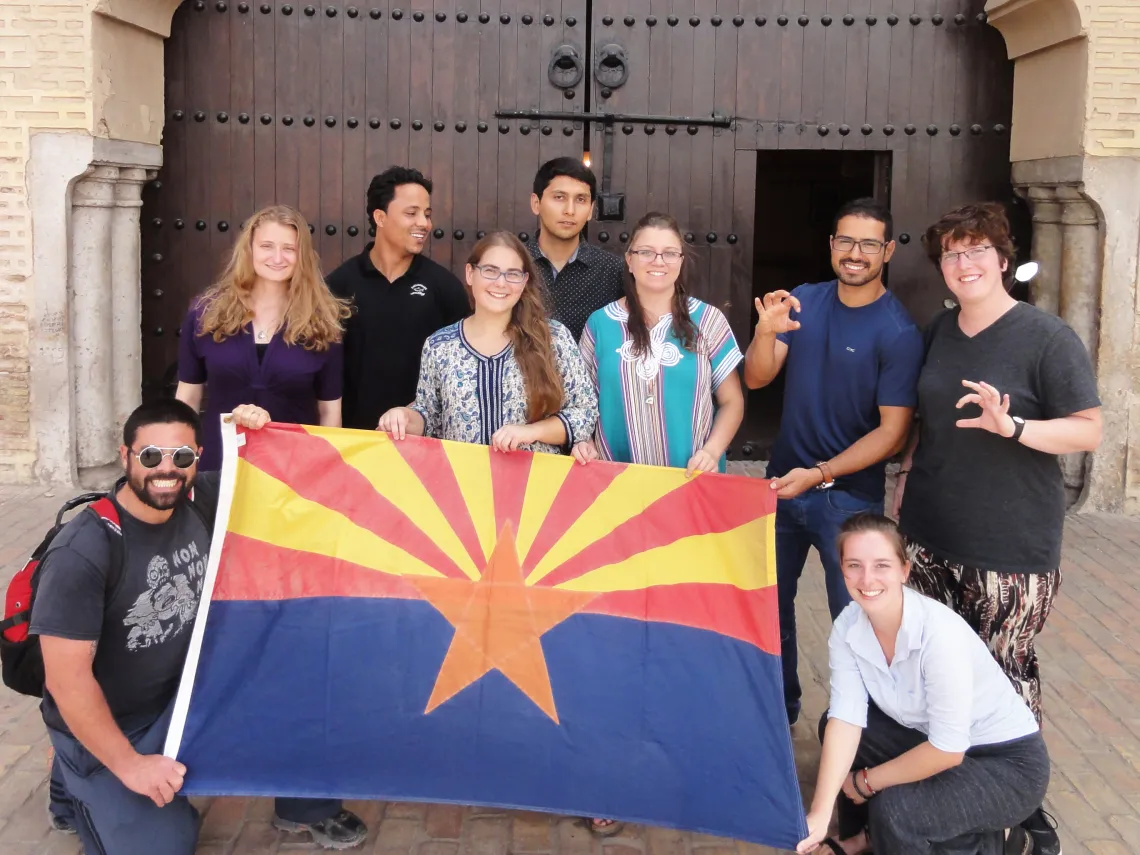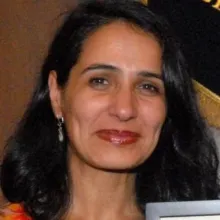With Arabic Flagship Program, UArizona Attracts New Students and Provides Virtual Immersion Experiences
The University of Arizona was awarded an Arabic Flagship Grant for four more years, allowing for top-tier Arabic training – including virtual immersion experiences – to all Arabic learners.

Arizona Arabic Flagship students during a study abroad trip to Meknes, Morocco, before COVID-19. Over the summer, students participated in interactive virtual tours of Morocco.
Over the summer, Arabic classes at the University of Arizona were three times their normal size. In addition to learning Arabic with new web-based materials, students could participate in virtual cultural activities with people in Morocco.
Such programming is possible in part because of funding from the Arizona Arabic Flagship Program, which has won a new $1.4 million grant for 2020-2024 – plus summer and year-long study abroad scholarships for each Flagship student – from the National Security Education Program. The federal program supports the learning of languages considered critical for U.S national security and economic competitiveness.
The University of Arizona is one of only six institutions in the country selected to host an Arabic Flagship Program, which helps undergraduate students from diverse majors reach superior-level fluency in Arabic by graduation. Housed in the School of Middle Eastern and North African Studies in the College of Social and Behavioral Sciences, the Arizona Arabic Flagship Program is directed by MENAS Associate Professor Sonia Shiri.
“Language Flagship students belong to a distinguished national cohort of future leaders who possess language and cultural training that is rarely attainable at the undergraduate level,” said Shiri. “Our graduates find the Flagship Program prepares them for a variety of careers, and their advanced Arabic and global experience makes them desirable job and graduate school applicants.”
"The University of Arizona is committed to preparing students for success at the local, regional, national and global levels. To succeed in next-generation careers, students ideally will know a second language and have a deep understanding of and appreciation for the diverse cultures of our world," said University of Arizona President Robert C. Robbins. "This funding underscores the strength of our Arabic program and will help support our students as they develop the skills in this critical area. I am incredibly proud we were selected to host this program and I am excited for what this will mean for our students."
The Arabic Flagship Program is one of several indicators of the excellence of the Arabic program at the University of Arizona. The university offers Arabic Project Global Officer, or Project GO, a federally funded program which improves the language competency, regional expertise and intercultural communication skills of ROTC students. A year ago, the university took over from Harvard as host of the Center for Arabic Study Abroad, or CASA, a national program considered the pinnacle of Arabic training.
The university also offers an Arabic major and a Jumpstart Arabic program for high school juniors and incoming first-year students.
Arizona Flagship students study a variety of colloquial Arabic dialects in addition to Modern Standard Arabic. The rigorous program promotes accelerated learning, and Flagship students receive one-on-one tutoring twice a week. Students are also paired with native speakers from campus who meet with them every week to practice Arabic in a more unstructured environment.
Flagship students can apply for Flagship scholarship money for a summer abroad or for their required capstone year of overseas study in Morocco. For this grant cycle, the University of Arizona is supplementing those funds, making participation nearly cost-free to qualifying students.
UArizona also partnered with the University of Hawaii’s Flagship Technology Innovation Center to create a technology-mediated program that teaches Moroccan Arabic to Flagship students before they go to Morocco. Shiri is the project lead and is piloting the course in the Arizona Arabic Flagship program prior to its use by the other five Flagship institutions.
Creating a Virtual Immersion Experience During a Pandemic
This summer, the Arizona Arabic Program attracted roughly 80 students from around the country in each of its two, five-week summer sessions, which was triple the number of students usually enrolled. Many students who normally would have studied abroad signed up, including Project GO students and students from other universities. The sessions also included students from the Jumpstart Arabic Program.
In response to this demand for Arabic, Shiri quickly adapted the curriculum to the realities of the pandemic by creating new web-based materials for three levels of Arabic. Self-paced learning outside the classroom was paired with active engagement in the virtual classroom.
Trying to replicate the cultural immersion of study abroad was an additional challenge.

“One of the things we wanted to solve was how to give students a taste of an overseas environment while they are sitting at home,” Shiri said. “And that was something we wanted to solve not just for the Flagship students, but for all participants – the Project GO students, the Jumpstart students, and other independent students who came to us from all over the U.S. We decided to give everyone the opportunity to participate in the virtual cultural program we created.”
Shiri devised the cultural curriculum with Driss Cherkaoui, academic director of the overseas partner institution, Arab American Language Institute in Morocco, or AALIM, based in Meknes, Morocco.
In addition to attending guest lectures and film screenings, students participated in cultural clubs and interactive virtual tours of Morocco. The cooking and music clubs were led by instructors from AALIM, while the calligraphy club was led by Abdessalem Choura, a UArizona instructor. The interactive tours, led by AALIM instructors and local experts, took students in real time around the old medina of Meknes to acquaint them with its souks (traditional markets), historical landmarks, Andalusian architecture, art and traditions.
“The traditional herbal medicine bazaar was surprisingly the most popular destination,” Shiri noted.
Shiri added, “The biggest challenge was the technology failing on us, like in the bazaars deep in the middle of the old town, where the walls are really thick adobe. Our partners bought a new wi-fi booster, which helped.”
Attracting New Students
The Arabic Jumpstart Program has been a pipeline for students coming to the University of Arizona and joining the Arabic Flagship Program. The Jumpstart Program allows high school juniors and seniors to take an intensive Arabic summer course for college credit at a reduced tuition rate. Incoming UArizona students can receive a scholarship from the Flagship Program to supplement their tuition and fees for the summer session and are assigned tutors and mentors.
This year 31 of the 33 Jumpstart students came from outside Arizona. Six of the Jumpstart students have enrolled at the University of Arizona this fall as Flagship students, and two are the first ever to start in fourth-year Arabic.
Claire Holloway started this fall as an Arizona Flagship student after two summers of participating in the Jumpstart program. She is majoring in Arabic, PPEL (philosophy, politics, economics and law), and Middle Eastern and North African studies and wants to pursue a career in diplomacy or international law after graduation.
“I had always wanted to join a Flagship school and complete my capstone year in Morocco, and I ended up choosing the UA because of the amount and quality of programs offered,” Holloway said. “There is the Jumpstart program of course, and the UA now hosts the CASA program. In addition, Flagship gives us small-group tutoring sessions which provides us with the one-on-one assistance we need. I'm so glad to be a student with the Arizona Flagship program!”

